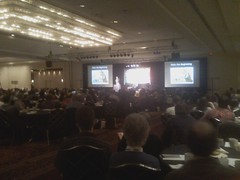 I made it to New Orleans after the seemingly requisite travel drama late yesterday afternoon. This morning's session started out with David Pogue, technology writer with the New York Times (a very sad cell phone photo, left, shows Pogue giving his address.) More on that soon.
I made it to New Orleans after the seemingly requisite travel drama late yesterday afternoon. This morning's session started out with David Pogue, technology writer with the New York Times (a very sad cell phone photo, left, shows Pogue giving his address.) More on that soon.I'm listening now to a panel convened and moderated by a group called Sea Change, who talks about usability. "Don't Make Me Think" is a book that describes how to create usability tests (which we will be using for the Commons!). A great deal of emphasis is placed on a few core items that don't seem to apply to the RE-AMP Commons, like "how to donate" buttons. However, there are a number of takeaways.
According to this workshop, a compelling web page has three basic elements:
* Introduce the organization. A user should be able to walk away knowing who the organization is and what they do without digging or clicking on a link.
* Compelling call to donate. This isn't applicable to RE-AMP (except, perhaps, for prospective large funders).
* Effective layout. This is a bullet point on the slide, but I'm not quite sure how this is quantified yet.
After 5-7 links on a page, users start to "turn off" and become overwhelmed.
We're looking at examples, now, of live websites. There are folks with Environmental Defense and several other folks on the panel, and a few other brave nonprofits--DARTS, YouthNoise, and American Friends Service Committee--are currently being discussed as case studies (brave folks!).
MobileActive, a group that uses cell phones as advocacy tools, was another group that was used as a case study. This was especially useful because this site is also based on Drupal, the same platform as the RE-AMP Commons; Drupal is also undergoing usability testing. An update on Drupal's usability efforts here.
A few nuggets from the q/a session:
Analytics is used to formulate questions; user testing answers the question "why."
Browsercam.com takes pictures of your site in different browsers/platforms.
Crazyegg.com allows folks to take mouse heatmaps of websites to see where folks actually mouse over on a particular page.
People scan for headlines after looking at pictures and expect pictures to be clickable.
That's it--off to lunch!
No comments:
Post a Comment